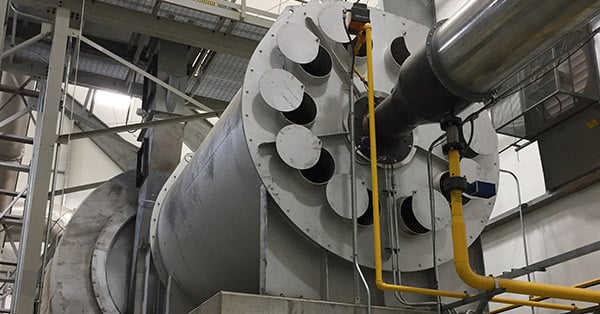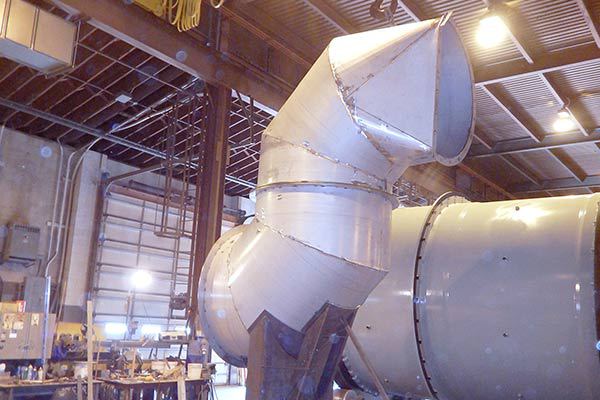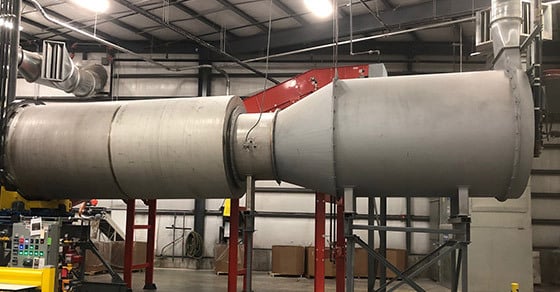Rotary drum dryers are a central component in a wide range of industrial processes. These highly flexible industrial dryers can be configured to create a custom processing solution for optimal dryer performance.
While not necessary in every setting and still critical in others, combustion chambers offer several benefits that can contribute significantly to product quality and overall process efficiency. The following provides an overview on combustion chambers, including the many benefits they offer and when they are an essential add-on to the rotary dryer.
About Combustion Chambers

A combustion chamber consists of a static vessel (usually cylindrical), typically constructed from steel, with multiple air inlets for efficient combustion. A burner is mounted on the end of the combustion chamber, which is connected to the end of the dryer. The chamber is refractory lined to protect the shell walls from the high temperatures. A single shell is typical, but in some cases double shell designs are available to pre heat the air.
The combustion chamber is used to house the combustion reaction that feeds heat into the dryer, preventing direct contact between the flame and the material being processed. It can be used on either a co-current or counter-current design.
When a combustion chamber is not used, the burner is simply mounted directly onto the end of the dryer, so that the flame is present in the drum itself, allowing direct contact between the flame and the material being processed.
Some consider these two variations as subtypes of the direct dryer category; “direct-fired,” referring to when the flame is in direct contact with the material, and “direct-heat” referring to when the flame is kept away from the material through the use of a combustion chamber.

FEECO Combustion Chamber with burner mounted on a FEECO Drum Dryer
When is a Combustion Chamber Necessary?
In some cases, depending on the product undergoing drying, a combustion chamber may be critical to the process. Products that are heat sensitive, flammable, or might break down under a flame, should not be processed in direct contact with a flame. Many materials are sensitive to heat and could break down or be damaged by flame, resulting in off-spec product and a high amount of attrition (the breakdown of product into fines and dust).
In cases where the material being processed is especially heat sensitive, the combustion chamber design can be used to reduce the amount of radiative heat transfer imparted on the material. For this, right angle designs are often employed, eliminating the direct path between the products of combustion and the material being processed.
Additionally, some materials, such as potash, will form undesirable pollutants if exposed to a flame, increasing the requirements of the air pollution control system and potentially presenting regulatory hurdles.
In cases such as these, the use of a combustion chamber is vital to keeping emissions under control and ensuring product integrity.
When is a Combustion Chamber Not Necessary?
Combustion chambers are not always necessary. When product quality is not a concern and the presence of a direct flame does not produce any undesirable byproducts, producers can avoid the extra expense of a combustion chamber.
This is frequently seen in industries processing low-value products, such as asphalt or low-grade aggregates. The flame presents no problem to the material and essentially flashes off moisture by direct contact, reducing the required retention time.
Benefits of a Rotary Dryer With a Combustion Chamber
In settings where they are not required, combustion chambers still prove advantageous to the process by providing several benefits:
High-Quality Product
The use of a combustion chamber promotes improved product quality. By preventing the material from being exposed to the flame, attrition is minimized and materials sensitive to heat are not over-exposed.
Enhanced Control
The inclusion of a combustion chamber also increases process control. Through the use of a combustion chamber and dilution air fan, the process gas temperature entering the dryer is more readily controllable, as well as more uniform. This enhanced control is often used to optimize the temperatures entering the drum according to the specific needs of the material being processed, while uniform heat yields more uniform drying results.
Longer Dryer Life
Because the flame is not in direct contact with the dryer shell, the separation of the combustion reaction and flame from the drum dryer promotes a longer dryer lifespan.
Greater Efficiency
The ability to more readily control the temperatures entering the dryer improves overall process efficiency. Efficiency is further enhanced because dilution air can be incorporated into the process, promoting a more complete combustion of the fuel source and providing an outlet for recovered waste heat to be reused, reducing energy requirements.
Upgrading Existing Dryer Systems With a Combustion Chamber
As a result of the benefits that can be garnered, it is often desirable to retrofit an existing dryer system with a combustion chamber; many producers who initially opted to go without are finding themselves turning to combustion chambers to improve process efficiency, increase capacity, reduce pollutants, and/or improve product quality.
Combustion chambers are easily retrofitted onto existing rotary dryers; while space is often a limiting factor in incorporating additional equipment into a system, combustion chambers are flexible by design. Manufacturers can build combustion chambers to fit into a variety of different spaces. This might mean utilizing space above or below the dryer to direct combustion gases into the unit. The image below, for example, shows the custom ducting FEECO designed to allow the use of a combustion chamber on a separate floor from the rotary dryer at the customer’s plant.

Custom ducting designed by FEECO for connecting the combustion chamber and rotary dryer on different floors.
Conclusion
Combustion chambers are essential to maintaining product quality and improving efficiency when drying material with a rotary dryer. They are not, however, necessary in all settings, and are often left off when product quality and pollutant byproducts are not a concern. Combustion chambers offer a range of benefits to industrial drying and are easily retrofitted onto existing dryer systems for improved efficiency.
FEECO is the world’s leading rotary dryer manufacturer. We can engineer a custom combustion chamber as part of a new dryer design, or for retrofitting an existing system. All FEECO combustion chambers are built to the highest quality standards and feature unique designs to maximize efficiency and combustion chamber lifespan. For more information on our combustion chambers or rotary dryers, contact us today!



